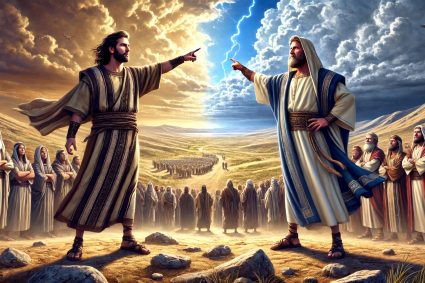


Lesson 3.Controversies
The Controversies Surrounding Jesus’ Ministry
In Lesson 3 of the Gospel of Mark, we encounter a series of controversies that Jesus faced with the religious leaders and his own family. These disputes reveal not only the challenges that Jesus encountered in his earthly ministry but also profound truths about his character, mission, and the nature of true faith.
The healing of the paralytic, the calling of Levi and the question of fasting, the dispute over the Sabbath, and the reactions to Jesus’ tireless work—all these events demonstrate how Jesus’ radical message and actions met with resistance and misunderstanding. It becomes clear that Jesus did not come to confirm existing religious structures but to question and renew them.
In these controversies, Jesus redefines fundamental principles: Faith is manifested in acts of love, compassion takes precedence over rigid religious rules, and true community is based on shared obedience to God’s will. Through his responses and actions, Jesus invites his listeners to enter into a deeper and more authentic relationship with God.
This lesson challenges us to examine our own faith and religious practices. It calls us to recognize and live out the true spirit of the Gospel by practicing compassion, flexibility, and a strong commitment to God’s will in our daily lives.

3.1 Healing a Paralytic
Faith, Healing, and the Power of Forgiveness
Read Mark 2:1-12. What was the paralytic seeking when he was brought to Jesus, and what did he receive?
The paralytic in Mark 2:1-12 was seeking healing when his four friends brought him to Jesus. This physical healing was the obvious goal of their efforts, as shown by their removing the roof and lowering the paralytic down to Jesus. This was an extraordinary expression of their faith and persistence. Jesus recognized this faith and responded by first forgiving the paralytic’s sins.
Faith can be seen through the actions it inspires. The paralytic’s friends demonstrated their faith through their determination and effort to bring their friend to Jesus despite the obstacles they faced. This illustrates that faith, like love, becomes visible through actions. The friends’ faith led them to spare no effort to help their friend.
Jesus’ initial response of forgiving the paralytic’s sins addresses a deeper need than physical infirmity. This shows that Jesus considers holistic healing, encompassing both physical and spiritual aspects. The forgiveness of sins was a central point that Jesus wanted to emphasize, even though it was not what the onlookers expected.
The religious leaders who witnessed this scene doubted Jesus’ authority to forgive sins and considered his words blasphemous. Jesus met this doubt with a rabbinical argumentation style known as “from the lesser to the greater.” By healing the paralytic and enabling him to walk, Jesus demonstrated his divine authority and confirmed his ability to forgive sins.
This event in Mark shows the depth of faith and Jesus’ power to bring both spiritual and physical healing. It teaches us that true faith is often visible through determined and loving actions, and that Jesus addresses both our visible and invisible needs.
Read Micah 6:6-8. How does this text explain what was happening between Jesus and the leaders?
In Micah 6:6-8, the prophet Micah calls the people to reflect on God’s true requirements. Instead of emphasizing outward sacrifices and rituals, the text explains that God desires justice, mercy, and humble conduct before Him. These principles contrast with mere religious formalities and emphasize an inner attitude of dedication and ethics.
This lesson from Micah directly applies to the interactions between Jesus and the religious leaders of his time. The religious leaders focused their attention on adhering to and defending external religious practices and traditions. They were so focused on their own conception of piety and law that they neglected the core principles of justice, mercy, and humility.
Jesus embodied and taught these essential values, yet the religious leaders did not recognize this. Their obsession with defending their view of God and religion made them blind to God’s work happening right before their eyes. Even when Jesus read their thoughts and healed the paralytic—clear evidence of his divine authority—they did not change their minds. Their hearts were hardened, and they could not interpret the signs that should have shown them that Jesus was truly sent by God.
Micah 6:6-8 reminds us that true religiosity lies not in outward rituals but in living a life of justice, mercy, and humility before God. These values should be at the heart of our faith and actions. The religious leaders in Jesus’ time forgot this, and thus missed the deeper truth that Jesus was revealing to them. Their inability to recognize the significance of his actions illustrates the danger of prioritizing the external form of religion over its inner values.
How can we ensure that we do not fall into the same trap as these men, becoming so obsessed with the forms of religion that we lose sight of what true religion is all about (see James 1:27)?
James 1:27 describes true religion as “to look after orphans and widows in their distress and to keep oneself from being polluted by the world.” This definition directs our focus away from external forms and rituals toward practical love and personal integrity. To avoid falling into the same trap as the religious leaders in Jesus’ time, we should consider the following principles in our faith life:
-
Focus on Charity:
-
Active Engagement: Actively participate in your community and society by helping those in need. Look for opportunities to serve others and alleviate their suffering.
-
Empathy and Compassion: Develop an open heart for the needs of others. Try to understand the perspectives of those who are less fortunate and be willing to stand by them.
-
-
Justice and Mercy:
-
Promoting Social Justice: Engage in promoting just structures in your community and society. Advocate for fair treatment and opportunities for all.
-
Practicing Mercy: Be ready to forgive and show compassion. Remember that Jesus calls us to mercy, not judgment.
-
-
Humility before God:
-
Humble Heart: Recognize your own limitations and dependence on God. Be open to His guidance and willing to lay aside your own pride and ego.
-
Living According to God’s Will: Seek God’s will through prayer and Bible study. Strive to implement His commandments in your daily life.
-
-
Purity and Integrity:
-
Moral Purity: Endeavor to live a life characterized by honesty, faithfulness, and moral integrity. Avoid temptations and influences that might lead you away from God’s ways.
-
Self-Reflection and Repentance: Regularly examine your heart and motives. Be willing to admit mistakes and practice repentance when you have strayed.
-
-
Balance between Tradition and Heart:
-
Appreciation of Tradition: Traditions and rituals can be valuable if they help us deepen our faith and strengthen our community. However, ensure they do not become an end in themselves.
-
Priority of the Heart: Ensure that your religious practices come from a sincere heart that loves God and neighbor.
-
By adhering to these principles, we can avoid falling into the same trap as the religious leaders who lost sight of the true values of religion. Instead, we can maintain a vibrant, authentic, and transformative relationship with God and our fellow humans that aligns with the true religion described in James 1:27.

The story of the healing of the paralytic in Mark 2:1-12 offers valuable lessons for our daily lives and faith. Here are some practical connections:
-
Faith that Shows in Actions:
-
Practical Application: Our faith should be reflected in our actions. Like the friends of the paralytic, we should be willing to overcome obstacles to help others and make God’s love visible.
-
Engagement: Actively seek opportunities to live out your faith in everyday life. This could be through volunteer work, supporting those in need, or through small daily acts of kindness and compassion.
-
-
Community and Support:
-
Joint Efforts: The story highlights the importance of community. The paralytic’s friends worked together to bring him to Jesus. In our lives, we should seek and offer support and fellowship with other believers.
-
Networks of Help: Build and maintain relationships that can help you stay strong in faith and find support in times of need. Be ready to provide this support to others as well.
-
-
Trust in Jesus’ Power and Authority:
-
Faith in God’s Intervention: Believe that Jesus can still intervene in our lives today. This can be through prayer, faith, and trust in His guidance and healing.
-
Forgiveness and Healing: Remember that Jesus brings both spiritual and physical healing. Seek not only material or physical solutions but also spiritual renewal and forgiveness.
-
-
Humility and Openness:
-
Heart Attitude: Maintain a humble and open attitude toward God’s work in your life and in the lives of others. The religious leaders missed God’s work because they were proud and narrow-minded.
-
Learning and Growing: Be willing to learn from various experiences and people. Stay open to what God wants to show you through different circumstances and encounters.
-
-
Mercy and Forgiveness:
-
Practicing Mercy: Just as Jesus first forgave the paralytic’s sins, we should learn to be merciful and forgive others. This promotes healing and reconciliation in our relationships.
-
Genuine Compassion: Show compassion for the needs of others, both physical and spiritual. Let your actions be characterized by love and mercy.
-
-
Active Steps of Faith:
-
Taking Initiative: The friends of the paralytic did not wait passively but took the initiative. Be willing to take active steps to find solutions and seek God’s help.
-
Faith in Action: Let your faith be visible through concrete actions, whether in your personal life, family, workplace, or church.
-
By implementing these principles in our daily lives, we can maintain a vibrant and transformative relationship with God and our fellow humans, strengthening our faith and serving others. The story of the healing of the paralytic encourages us to live an active, engaged, and compassionate faith.

Let our faith be visible through bold acts of love and perseverance, for true faith is shown in action, just as the friends of the paralytic brought their friend to Jesus.
(Visited 25 times, 1 visits today)




















